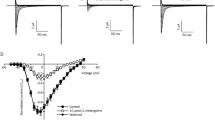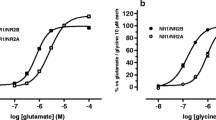Abstract
The neurosteroids pregnenolone, progesterone, and dehydroepiandrosterone (DHEA) occur naturally in the nervous system. They act on neural tissues, participate in neuronal signaling, and are reported to alter neuronal excitability via nongenomic mechanisms. Muscarinic receptors have important roles in neuronal functions in the brain and autonomic nervous system. In this study, we investigated the effects of pregnenolone, progesterone, and DHEA on M1 and M3 muscarinic receptors using the Xenopus oocyte expression system. Pregnenolone and progesterone inhibited the acetylcholine (ACh)-mediated responses of M1 and M3 receptors expressed in Xenopus oocytes, whereas DHEA did not. The half-maximal inhibitory concentrations (IC50) for pregnenolone inhibition of M1 receptor- and M3 receptor-mediated currents were 11.4 and 6.0 μM respectively; the IC50 values for progesterone inhibition of M1 receptor- and M3 receptor-mediated currents were 2.5 and 3.0 μM respectively. The selective protein kinase C (PKC) inhibitor GF109203X had little effect on the pregnenolone or progesterone inhibition of the ACh-induced currents in Xenopus oocytes expressing M1 or M3 receptors. The inhibitory effects of pregnenolone and progesterone were overcome at higher concentrations of ACh. Pregnenolone and progesterone inhibited the [3H]quinuclidinyl benzilate (QNB) binding to M1 and M3 receptor expressed in Xenopus oocytes, and Scatchard plot analysis of [3H]QNB binding revealed that pregnenolone and progesterone altered the Kd value and the Bmax, indicating noncompetitive inhibition. In conclusion, pregnenolone and progesterone inhibited M1 and M3 receptor functions noncompetitively by the mechanism independent of PKC and by interfering with ACh binding to the receptors.






Similar content being viewed by others

References
Brussaard AB, Koksma JJ (2003) Conditional regulation of neurosteroid sensitivity of GABAA receptors. Ann NY Acad Sci 1007:29–36
Caulfield MP (1993) Muscarinic receptors—characterization, coupling and function. Pharmacol Ther 58:319–379
Christopoulos A, Kenakin T (2002) G protein-coupled receptor allosterism and complexing. Pharmacol Rev 54:323–374
Darnaudery M, Koehl M, Pallares M, Le Moal M, Mayo W (1998) The neurosteroid pregnenolone sulfate increases cortical acetylcholine release: a microdialysis study in freely moving rats. J Neurochem 71:2018–2022
Darnaudery M, Koehl M, Piazza PV, Le Moal M, Mayo W (2000) Pregnenolone sulfate increases hippocampal acetylcholine release and spatial recognition. Brain Res 852:173–179
Do SH, Kamatchi GL, Durieux ME (2001) The effects of isoflurane on native and chimeric muscarinic acetylcholine receptors: the role of protein kinase C. Anesth Analg 93:375–381
Durieux ME (1995a) Halothane inhibits signaling through M1 muscarinic receptors expressed in Xenopus oocytes. Anesthesiology 82:174–182
Durieux ME (1995b) Inhibition by ketamine of muscarinic acetylcholine receptor function. Anesth Analg 81:57–62
Durieux ME (1996) Muscarinic signaling in the central nervous system. Recent developments and anesthetic implications. Anesthesiology 84:173–189
Fibiger HC (1991) Cholinergic mechanisms in learning, memory and dementia: a review of recent evidence. Trends Neurosci 14:220–223
Flood JF, Smith GE, Roberts E (1988) Dehydroepiandrosterone and its sulfate enhance memory retention in mice. Brain Res 447:269–278
Flood JF, Morley JE, Roberts E (1992) Memory-enhancing effects in male mice of pregnenolone and steroids metabolically derived from it. Proc Natl Acad Sci USA 89:1567–1571
Flood JF, Morley JE, Roberts E (1995) Pregnenolone sulfate enhances post-training memory processes when injected in very low doses into limbic system structures: the amygdala is by far the most sensitive. Proc Natl Acad Sci USA 92:10806–10810
Frye CA, Sturgis JD (1995) Neurosteroids affect spatial/reference, working, and long-term memory of female rats. Neurobiol Learn Mem 64:83–96
Harris RA, Mihic SJ, Dildy-Mayfield JE, Machu TK (1995) Actions of anesthetics on ligand-gated ion channels: role of receptor subunit composition. FASEB J 9:1454–1462
Harrison NL, Majewska MD, Harrington JW, Barker JL (1987) Structure–activity relationships for steroid interaction with the gamma-aminobutyric acidA receptor complex. J Pharmacol Exp Ther 241:346–353
Holzbauer M (1976a) Physiological aspects of steroids with anaesthetic properties. Med Biol 54:227–242
Holzbauer M (1976b) Proceedings: physiological aspects of the hypnotic properties of steroid hormones. Br J Pharmacol 56:382–382
Isaacson RL, Varner JA, Baars JM, De Wied D (1995) The effects of pregnenolone sulfate and ethylestrenol on retention of a passive avoidance task. Brain Res 689:79–84
Jakubik J, Bacakova L, Lisa V, el-Fakahany EE, Tucek S (1996) Activation of muscarinic acetylcholine receptors via their allosteric binding sites. Proc Natl Acad Sci USA 93:8705–8709
Jensen AA, Spalding TA (2004) Allosteric modulation of G-protein coupled receptors. Eur J Pharm Sci 21:407–420
Kavaliers M, Ossenkopp KP, Prato FS, Innes DG, Galea LA, Kinsella DM, Perrot-Sinal TS (1996) Spatial learning in deer mice: sex differences and the effects of endogenous opioids and 60 Hz magnetic fields. J Comp Physiol A 179:715–724
Lambert JJ, Belelli D, Hill-Venning C, Peters JA (1995) Neurosteroids and GABAA receptor function. Trends Pharmacol Sci 16:295–303
Lazareno S, Birdsall NJ (1995) Detection, quantitation, and verification of allosteric interactions of agents with labeled and unlabeled ligands at G protein-coupled receptors: interactions of strychnine and acetylcholine at muscarinic receptors. Mol Pharmacol 48:362–378
Lena C, Changeux JP (1993) Allosteric modulations of the nicotinic acetylcholine receptor. Trends Neurosci 16:181–186
Majewska MD (1987a) Antagonist-type interaction of glucocorticoids with the GABA receptor-coupled chloride channel. Brain Res 418:377–382
Majewska MD (1987b) Steroids and brain activity. Essential dialogue between body and mind. Biochem Pharmacol 36:3781–3788
Majewska MD, Schwartz RD (1987) Pregnenolone-sulfate: an endogenous antagonist of the gamma-aminobutyric acid receptor complex in brain? Brain Res 404:355–360
Matsui H, Lazareno S, Birdsall NJ (1995) Probing of the location of the allosteric site on m1 muscarinic receptors by site-directed mutagenesis. Mol Pharmacol 47:88–98
Meziane H, Mathis C, Paul SM, Ungerer A (1996) The neurosteroid pregnenolone sulfate reduces learning deficits induced by scopolamine and has promnestic effects in mice performing an appetitive learning task. Psychopharmacology (Berl) 126:323–330
Minami K, Yanagihara N, Toyohira Y, Tsutsui M, Shigematsu A, Wada A, Izumi F (1994) Isoflurane inhibits nicotinic acetylcholine receptor-mediated 22Na+ influx and muscarinic receptor-evoked cyclic GMP production in cultured bovine adrenal medullary cells. Naunyn-Schmiedebergs Arch Pharmacol 349:223–229
Minami K, Minami M, Harris RA (1997a) Inhibition of 5-hydroxytryptamine type 2A receptor-induced currents by n-alcohols and anesthetics. J Pharmacol Exp Ther 281:1136–1143
Minami K, Vanderah TW, Minami M, Harris RA (1997b) Inhibitory effects of anesthetics and ethanol on muscarinic receptors expressed in Xenopus oocytes. Eur J Pharmacol 339:237–244
Pallares M, Darnaudery M, Day J, Le Moal M, Mayo W (1998) The neurosteroid pregnenolone sulfate infused into the nucleus basalis increases both acetylcholine release in the frontal cortex or amygdala and spatial memory. Neuroscience 87:551–558
Peter JC, Wallukat G, Tugler J, Maurice D, Roegel JC, Briand JP, Hoebeke J (2004) Modulation of the M2 muscarinic acetylcholine receptor activity with monoclonal anti-M2 receptor antibody fragments. J Biol Chem 279:55697–55706
Reddy DS, Kulkarni SK (2000) Development of neurosteroid-based novel psychotropic drugs. Prog Med Chem 37:135–175
Shiga Y, Minami K, Shiraishi M, Uezono Y, Murasaki O, Kaibara M, Shigematsu A (2002) The inhibitory effects of tramadol on muscarinic receptor-induced responses in Xenopus oocytes expressing cloned M(3) receptors. Anesth Analg 95:1269–1273
Shiraishi M, Minami K, Uezono Y, Yanagihara N, Shigematsu A (2001) Inhibition by tramadol of muscarinic receptor-induced responses in cultured adrenal medullary cells and in Xenopus laevis oocytes expressing cloned M1 receptors. J Pharmacol Exp Ther 299:255–260
Shiraishi M, Shibuya I, Minami K, Uezono Y, Okamoto T, Yanagihara N, Ueno S, Ueta Y, Shigematsu A (2002) A neurosteroid anesthetic, alphaxalone, inhibits nicotinic acetylcholine receptors in cultured bovine adrenal chromaffin cells. Anesth Analg 95:900–906
Soderpalm AH, Lindsey S, Purdy RH, Hauger R, de Wit H (2004) Administration of progesterone produces mild sedative-like effects in men and women. Psychoneuroendocrinology 29:339–354
Toullec D, Pianetti P, Coste H, Bellevergue P, Grand-Perret T, Ajakane M, Baudet V, Boissin P, Boursier E, Loriolle F, Duhamel L, Charon D, Kirilovsky J (1991) The bisindolylmaleimide GF 109203X is a potent and selective inhibitor of protein kinase C. J Biol Chem 266:15771–15781
Wess J (1996) Molecular biology of muscarinic acetylcholine receptors. Crit Rev Neurobiol 10:69–99
Wess J, Blin N, Yun J, Schoneberg T, Liu J (1996) Molecular aspects of muscarinic receptor assembly and function. Prog Brain Res 109:153–162
Wilkinson M, Siauw M, Horackova M (1995) Modulation of cardiac M2 muscarinic receptor binding by progesterone-related steroids. J Mol Cell Cardiol 27:1831–1839
Wu FS, Gibbs TT, Farb DH (1991) Pregnenolone sulfate: a positive allosteric modulator at the N-methyl-d-aspartate receptor. Mol Pharmacol 40:333–336
Author information
Authors and Affiliations
Corresponding author
Rights and permissions
About this article
Cite this article
Horishita, T., Minami, K., Uezono, Y. et al. The effects of the neurosteroids: pregnenolone, progesterone and dehydroepiandrosterone on muscarinic receptor-induced responses in Xenopus oocytes expressing M1 and M3 receptors. Naunyn-Schmiedeberg's Arch Pharmacol 371, 221–228 (2005). https://doi.org/10.1007/s00210-005-1022-1
Received:
Accepted:
Published:
Issue Date:
DOI: https://doi.org/10.1007/s00210-005-1022-1



